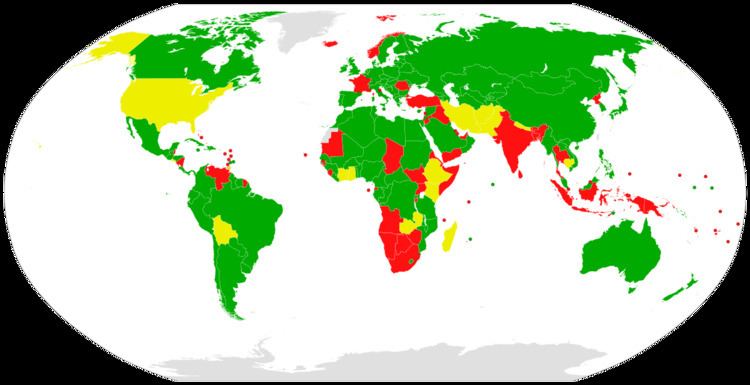Signed 23 May 1969 Effective 27 January 1980 Parties 114 (as of April 2014) | Signatories 45 | |
 | ||
Condition Ratification by 35 states | ||
The Vienna Convention on the Law of Treaties (VCLT) is a treaty concerning the international law on treaties between states. It was adopted on 22 May 1969 and opened for signature on 23 May 1969. The Convention entered into force on 27 January 1980. The VCLT has been ratified by 114 states as of April 2014. Some countries that have not ratified the Convention, such as the United States, recognize parts of it as a restatement of customary law and binding upon them as such.
Contents
History
The VCLT was drafted by the International Law Commission (ILC) of the United Nations, which began work on the Convention in 1949. During the twenty years of preparation, several draft versions of the convention and commentaries were prepared by special rapporteurs of the ILC. James Brierly, Hersch Lauterpacht, Gerald Fitzmaurice and Humphrey Waldock were the four special rapporteurs. In 1966, the ILC adopted 75 draft articles which formed the basis for the final work. Over two sessions in 1968 and 1969, the Vienna Conference completed the Convention, which was adopted on 22 May 1969 and opened for signature the following day.
Content and effects
The Convention codifies several bedrocks of contemporary international law. It defines a treaty as "an international agreement concluded between states in written form and governed by international law," as well as affirming that "every state possesses the capacity to conclude treaties." The most important point in the Convention is that Article 1 restricts the application of the Convention to written treaties between States, excluding treaties concluded between the states and international organizations or international organizations themselves.
The Convention has been referred to as the "treaty on treaties"; it is widely recognized as the authoritative guide regarding the formation and effects of treaties. Even those countries who have not ratified it recognize its significance. For example, the United States recognizes that parts of the Convention constitute customary law binding on all nations. In India, the Supreme court has also recognised the customary status of the convention.
Scope
The scope of the Convention is limited. It applies only to treaties concluded between states, so it does not cover agreements between states and international organizations or between international organizations themselves, though if any of its rules are independently binding on such organizations, they remain so. It does apply, however, to treaties between states within an intergovernmental organization. However, agreements between states and international organizations, or between international organizations themselves, will be governed by the 1986 Vienna Convention on the Law of Treaties between States and International Organizations or Between International Organizations if it ever enters into force. Also, in treaties between states and international organizations, the terms of the Convention still apply between the state members. The Convention does not apply to agreements not in written form.
Parties to the convention
As of April 2014, there are 114 state parties that have ratified the convention, and a further 15 states have signed but have not ratified the convention. In addition, the Republic of China (Taiwan), which is currently only recognized by 20 UN member states, signed the Convention in 1970 prior to the United Nations General Assembly's vote to transfer China's seat to the People's Republic of China (PRC) in 1971. The PRC subsequently acceded to the Convention. 66 UN member states have neither signed nor ratified the Convention.
Vienna formula
International treaties and conventions contain rules about what entities could sign, ratify or accede to them. Some treaties are restricted to states that are members of the UN or parties to the Statute of the International Court of Justice. In rare cases there is an explicit list of the entities that the treaty is restricted to. More commonly the aim of the founding signatories is that the treaty is not restricted to particular states only and so a wording like "this treaty is open for signature to States willing to accept its provisions" is used (the so-called "All States formula").
When a treaty is open to "States", for the depositary authority it is difficult or impossible to determine which entities are States. If the treaty is restricted to Members of the United Nations or Parties to the Statute of the International Court of Justice, there is no ambiguity. However, a difficulty has occurred as to possible participation in treaties when entities which appeared otherwise to be States could not be admitted to the United Nations, nor become Parties to the Statute of the International Court of Justice owing to the opposition, for political reasons, of a permanent member of the Security Council or haven't applied for ICJ or UN membership. Since that difficulty did not arise as concerns membership in the specialized agencies, where there is no "veto" procedure, a number of those States became members of specialized agencies, and as such were in essence recognized as States by the international community. Accordingly, and in order to allow for as wide a participation as possible, a number of conventions then provided that they were also open for participation to States members of specialized agencies. The type of entry-into-force clause utilized in the Vienna Convention on the Law of Treaties was later called the "Vienna formula" and its wording was utilized by various treaties, conventions and organizations.
Some treaties that utilize it include provisions that in addition to these States any other State invited by a specified authority or organization (commonly the United Nations General Assembly or an institution created by the treaty in question) can also participate, thus making the scope of potential signatories even broader.
